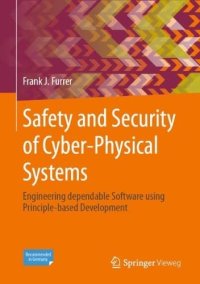
Ebook: Safety and Security of Cyber-Physical Systems: Engineering dependable Software using Principle-based Development
Author: Frank J. Furrer
- Year: 2022
- Publisher: Springer Vieweg
- Edition: 1st ed. 2022
- Language: English
- rar
Cyber-physical systems (CPSs) consist of software-controlled computing devices communicating with each other and interacting with the physical world through sensors and actuators. A CPS has, therefore, two parts: The cyber part implementing most of the functionality and the physical part, i.e., the real world. Typical examples of CPS’s are a water treatment plant, an unmanned aerial vehicle, and a heart pacemaker. Because most of the functionality is implemented in software, the software is of crucial importance. The software determines the functionality and many CPS properties, such as safety, security, performance, real-time behavior, etc. Therefore, avoiding safety accidents and security incidents in the CPS requires highly dependable software.
Methodology
Today, many methodologies for developing safe and secure software are in use. As software engineering slowly becomes disciplined and mature, generally accepted construction principles have emerged. This monograph advocates principle-based engineering for the development and operation of dependable software. No new development process is suggested, but integrating security and safety principles into existing development processes is demonstrated.
Safety and Security Principles
At the core of this monograph are the engineering principles. A total of 62 principles are introduced and catalogized into five categories: Business & organization, general principles, safety, security, and risk management principles. The principles are rigorous, teachable, and enforceable. The terminology used is precisely defined. The material is supported by numerous examples and enriched by illustrative quotes from celebrities in the field.
Final Words
«In a cyber-physical system’s safety and security, any compromise is a planned disaster»
Audience
First, this monograph is for organizations that want to improve their methodologies to build safe and secure software for mission-critical cyber-physical systems. Second, the material is suitable for a two-semester, 4 hours/week, advanced computer science lecture at a Technical University.
This textbook has been recommended and developed for university courses in Germany, Austria and Switzerland.